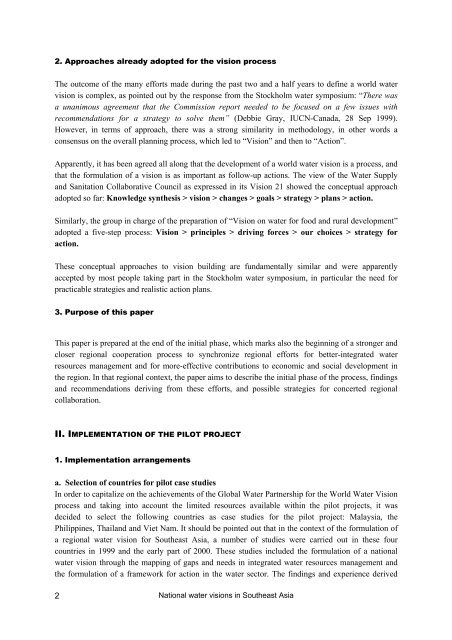The FAO-ESCAP pilot project on national water visions. From vision ...
The FAO-ESCAP pilot project on national water visions. From vision ...
The FAO-ESCAP pilot project on national water visions. From vision ...
You also want an ePaper? Increase the reach of your titles
YUMPU automatically turns print PDFs into web optimized ePapers that Google loves.
2. Approaches already adopted for the visi<strong>on</strong> process<br />
<str<strong>on</strong>g>The</str<strong>on</strong>g> outcome of the many efforts made during the past two and a half years to define a world <strong>water</strong><br />
visi<strong>on</strong> is complex, as pointed out by the resp<strong>on</strong>se from the Stockholm <strong>water</strong> symposium: “<str<strong>on</strong>g>The</str<strong>on</strong>g>re was<br />
a unanimous agreement that the Commissi<strong>on</strong> report needed to be focused <strong>on</strong> a few issues with<br />
recommendati<strong>on</strong>s for a strategy to solve them” (Debbie Gray, IUCN-Canada, 28 Sep 1999).<br />
However, in terms of approach, there was a str<strong>on</strong>g similarity in methodology, in other words a<br />
c<strong>on</strong>sensus <strong>on</strong> the overall planning process, which led to “Visi<strong>on</strong>” and then to “Acti<strong>on</strong>”.<br />
Apparently, it has been agreed all al<strong>on</strong>g that the development of a world <strong>water</strong> visi<strong>on</strong> is a process, and<br />
that the formulati<strong>on</strong> of a visi<strong>on</strong> is as important as follow-up acti<strong>on</strong>s. <str<strong>on</strong>g>The</str<strong>on</strong>g> view of the Water Supply<br />
and Sanitati<strong>on</strong> Collaborative Council as expressed in its Visi<strong>on</strong> 21 showed the c<strong>on</strong>ceptual approach<br />
adopted so far: Knowledge synthesis > visi<strong>on</strong> > changes > goals > strategy > plans > acti<strong>on</strong>.<br />
Similarly, the group in charge of the preparati<strong>on</strong> of “Visi<strong>on</strong> <strong>on</strong> <strong>water</strong> for food and rural development”<br />
adopted a five-step process: Visi<strong>on</strong> > principles > driving forces > our choices > strategy for<br />
acti<strong>on</strong>.<br />
<str<strong>on</strong>g>The</str<strong>on</strong>g>se c<strong>on</strong>ceptual approaches to visi<strong>on</strong> building are fundamentally similar and were apparently<br />
accepted by most people taking part in the Stockholm <strong>water</strong> symposium, in particular the need for<br />
practicable strategies and realistic acti<strong>on</strong> plans.<br />
3. Purpose of this paper<br />
This paper is prepared at the end of the initial phase, which marks also the beginning of a str<strong>on</strong>ger and<br />
closer regi<strong>on</strong>al cooperati<strong>on</strong> process to synchr<strong>on</strong>ize regi<strong>on</strong>al efforts for better-integrated <strong>water</strong><br />
resources management and for more-effective c<strong>on</strong>tributi<strong>on</strong>s to ec<strong>on</strong>omic and social development in<br />
the regi<strong>on</strong>. In that regi<strong>on</strong>al c<strong>on</strong>text, the paper aims to describe the initial phase of the process, findings<br />
and recommendati<strong>on</strong>s deriving from these efforts, and possible strategies for c<strong>on</strong>certed regi<strong>on</strong>al<br />
collaborati<strong>on</strong>.<br />
II. IMPLEMENTATION OF THE PILOT PROJECT<br />
1. Implementati<strong>on</strong> arrangements<br />
a. Selecti<strong>on</strong> of countries for <str<strong>on</strong>g>pilot</str<strong>on</strong>g> case studies<br />
In order to capitalize <strong>on</strong> the achievements of the Global Water Partnership for the World Water Visi<strong>on</strong><br />
process and taking into account the limited resources available within the <str<strong>on</strong>g>pilot</str<strong>on</strong>g> <str<strong>on</strong>g>project</str<strong>on</strong>g>s, it was<br />
decided to select the following countries as case studies for the <str<strong>on</strong>g>pilot</str<strong>on</strong>g> <str<strong>on</strong>g>project</str<strong>on</strong>g>: Malaysia, the<br />
Philippines, Thailand and Viet Nam. It should be pointed out that in the c<strong>on</strong>text of the formulati<strong>on</strong> of<br />
a regi<strong>on</strong>al <strong>water</strong> visi<strong>on</strong> for Southeast Asia, a number of studies were carried out in these four<br />
countries in 1999 and the early part of 2000. <str<strong>on</strong>g>The</str<strong>on</strong>g>se studies included the formulati<strong>on</strong> of a nati<strong>on</strong>al<br />
<strong>water</strong> visi<strong>on</strong> through the mapping of gaps and needs in integrated <strong>water</strong> resources management and<br />
the formulati<strong>on</strong> of a framework for acti<strong>on</strong> in the <strong>water</strong> sector. <str<strong>on</strong>g>The</str<strong>on</strong>g> findings and experience derived<br />
2<br />
Nati<strong>on</strong>al <strong>water</strong> visi<strong>on</strong>s in Southeast Asia
















